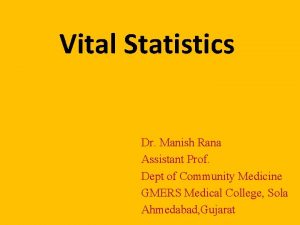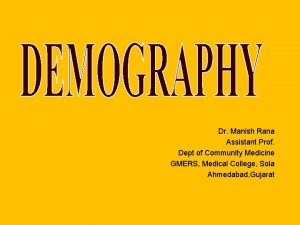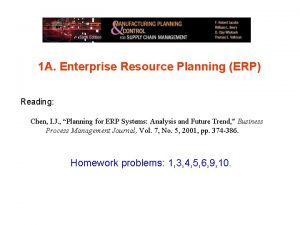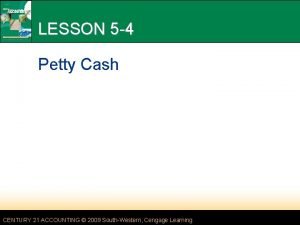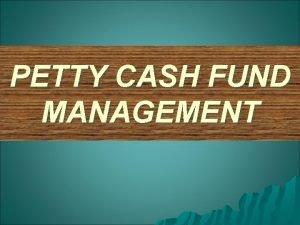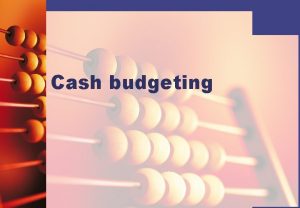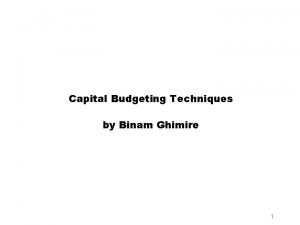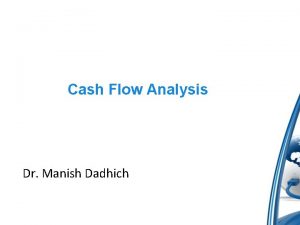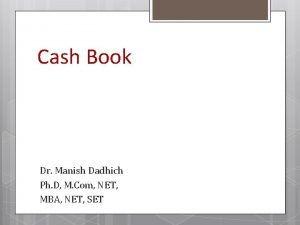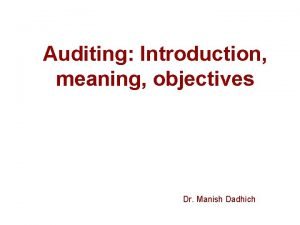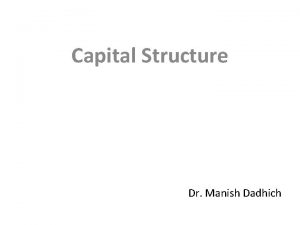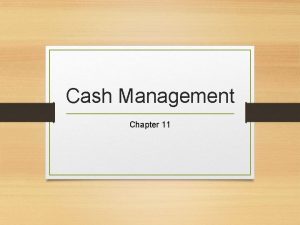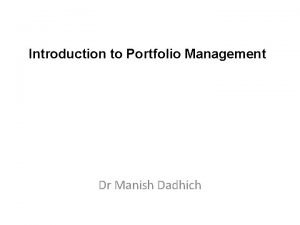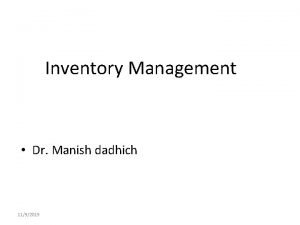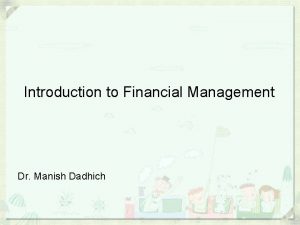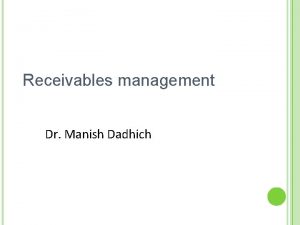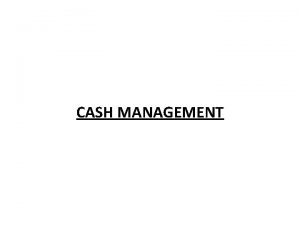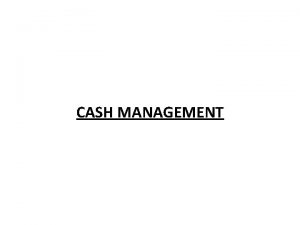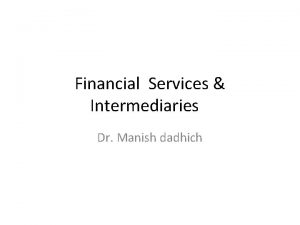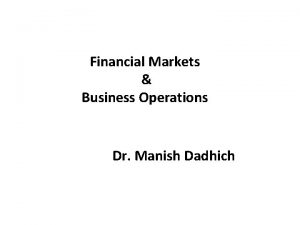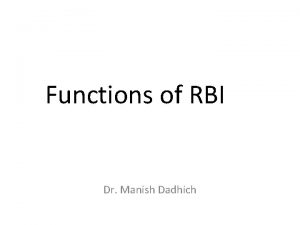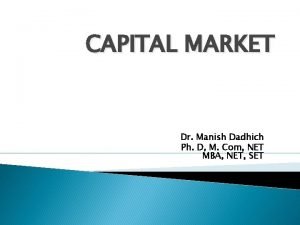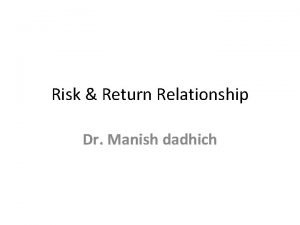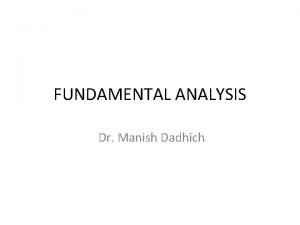Management of Cash Dr Manish Dadhich Meaning of




















- Slides: 20

Management of Cash Dr. Manish Dadhich

Meaning of Cash and Cash Equivalents • Cash generally refers to the coins, currency and cash equivalents like cheques, drafts, demand deposits, marketable securities, time deposits and so on. • However, cash as such does not have any earning power but still people hold cash because of the following motives:

Motives of holding cash

� � Transaction motive Precautionary motive Speculative motive Compensating motive

� � Holding of cash to meet routine cash requirements to finance the transactions which a firm carries on in the ordinary course of business. Cash is held to pay for goods or services. It is useful for conducting our everyday transactions or purchases.

• • The cash balances held in reserve for random and unforeseen fluctuations in cash flows. A cushion to meet unexpected contingencies. Floods, strikes and failure of imp customers – Unexpected slowdown in collection of accounts receivable – Sharp increase in cost of raw materials – Cancellation of some order of goods – • Defensive in nature

Is a motive for holding cash/near-cash to quickly take advantage of opportunities typically outside the normal course of business. � Positive and aggressive approach Helps to take advantage of: � � � An opportunity to purchase raw materials at reduced price � Make purchase at favorable prices � Delay purchase on anticipation of decline in prices � Buying securities when interest rate is expected to decline

Is a motive for holding cash/near-cash to compensate banks for providing certain services or loans. �Clients are supposed to maintain a minimum balance of cash at the bank which they cannot use themselves. �

Objectives of Cash Management There are two main objectives of Cash Management: 1. To meet the cash disbursement needs 2. To minimize funds committed to cash balances • These objectives though contradictory, but have to be achieved in order to manage cash effectively.

1. To meet the cash disbursement needs • In the ordinary course of business certain cash payments and cash receipts take place on a regular basis. • Thus, businesses need to maintain sufficient cash to meet the cash disbursement needs. Advantages of maintaining sufficient cash can be summarized as below:

Advantages of Maintaining Sufficient Cash Balance

2. To minimize funds committed to cash balances • Though it is important to maintain sufficient cash balances as can be seen from the figure above, but at the same time, • if large funds are lying idle, firm is losing out the money and not earning anything. Thus, optimal level of cash balances need to be maintained which is neither too high, nor too low.

Factors determining cash needs 1. Synchronization of Cash Flows: Cash balance needs to be maintained as cash receipts and cash payments occur at different times and in different amounts. If they reconcile at all times, the need for maintaining cash balance will be eliminated. 2. Short costs: In case there is a cash shortage, the firm may have to bear the burden of extra cost occurring due to the shortfall. Such costs include: • a. Borrowing Costs • b. Transaction Costs • c. Loss of cash discounts • d. Penalty costs • e. Loss in credit rating leading to higher interest rates in future, etc.

• 3. Excess cash balance costs: If the firm has excess cash, then also it bears the cost in the form of opportunity lost to earn interest on the excess cash, which could otherwise be invested elsewhere. • 4. Procurement needs: These are costs associated with establishing and operating cash management activities. • 5. Uncertainty: As the business operates in uncertainty, there are certain costs which crop up suddenly like immediate demand by supplier to make the payment, sudden rise in prices of raw materials, etc.

Cash Management Models Cash management models aim to minimize the cost and obtain the optimum level of cash balance. These are as follows: 5. 1 Baumol's Model– Cash Model under certainty According to this model there are two types of costs which need to be minimized: a. Cost of converting marketable securities into cash and b. Lost opportunity cost.

Baumol's Model The model can be summarized as follows: C = √������ /�� Where, C denotes optimal conversion amount per transaction b denotes cost of conversion into cash per transaction T denotes projected cash requirement during the planning period • i denotes opportunity interest rate per planning period • • •

• The monthly cash requiement of a company are Rs. 60, 000, fixed cost per transaction Rs. 10 and interest rate on marketable securities is 6 % pa. Find the optimum cash balance. • C= • • • C- Optimum cash level b- Fixed cost per transaction 10 t- total cash required during the period 60000 i- interests rate per month/year. 6/12=. 5 or. 005 Answer= 15492.

Summary • Cash refers to the currency and cash equivalents like cheques, drafts, demand deposits, marketable securities, time deposits and so on. • Motives of holding cash can be transaction motive, precautionary motive, speculative motive or compensating motive. • The two main objectives of cash management are to meet the cash disbursement needs and to minimize the funds committed to cash balance.

Summary • The factors determining the cash needs are – synchronization of the cash flows, short cash, excess cash balance, procurement needs and uncertainty. • Cash management models are Baumol’s model and Miller-Orr Model. The aim of the models is to identify the optimum level of cash balances to reach the objective of effective cash management • Cash Budget, one of the most important tools of cash management, helps to identify the net cash position of a firm, i. e. whether the firm has surplus or deficit of cash. Based on that the management works to manage it effectively. • Other techniques for cash management are speedy collection of cash receivables and slowing the disbursements.

Thx
 Dr pankaj dadhich
Dr pankaj dadhich Dr manish rana
Dr manish rana Dr manish rana
Dr manish rana Manish chaudhary mathura
Manish chaudhary mathura Aman chaudhary
Aman chaudhary Dr manish kumar gupta
Dr manish kumar gupta Manish noticewala md
Manish noticewala md Importance of equity
Importance of equity Manish parashar utah
Manish parashar utah Manish gupta
Manish gupta Cash to cash cycle time
Cash to cash cycle time Cash to cash cycle time
Cash to cash cycle time Cash in cash out example
Cash in cash out example Which budget shows anticipated cash flows
Which budget shows anticipated cash flows Paid cash to replenish the petty cash fund
Paid cash to replenish the petty cash fund A form showing proof of a petty cash payment.
A form showing proof of a petty cash payment. Petty cash management
Petty cash management Fcff meaning
Fcff meaning What is a budget
What is a budget Multiple irr example
Multiple irr example Man in black johnny cash meaning
Man in black johnny cash meaning

